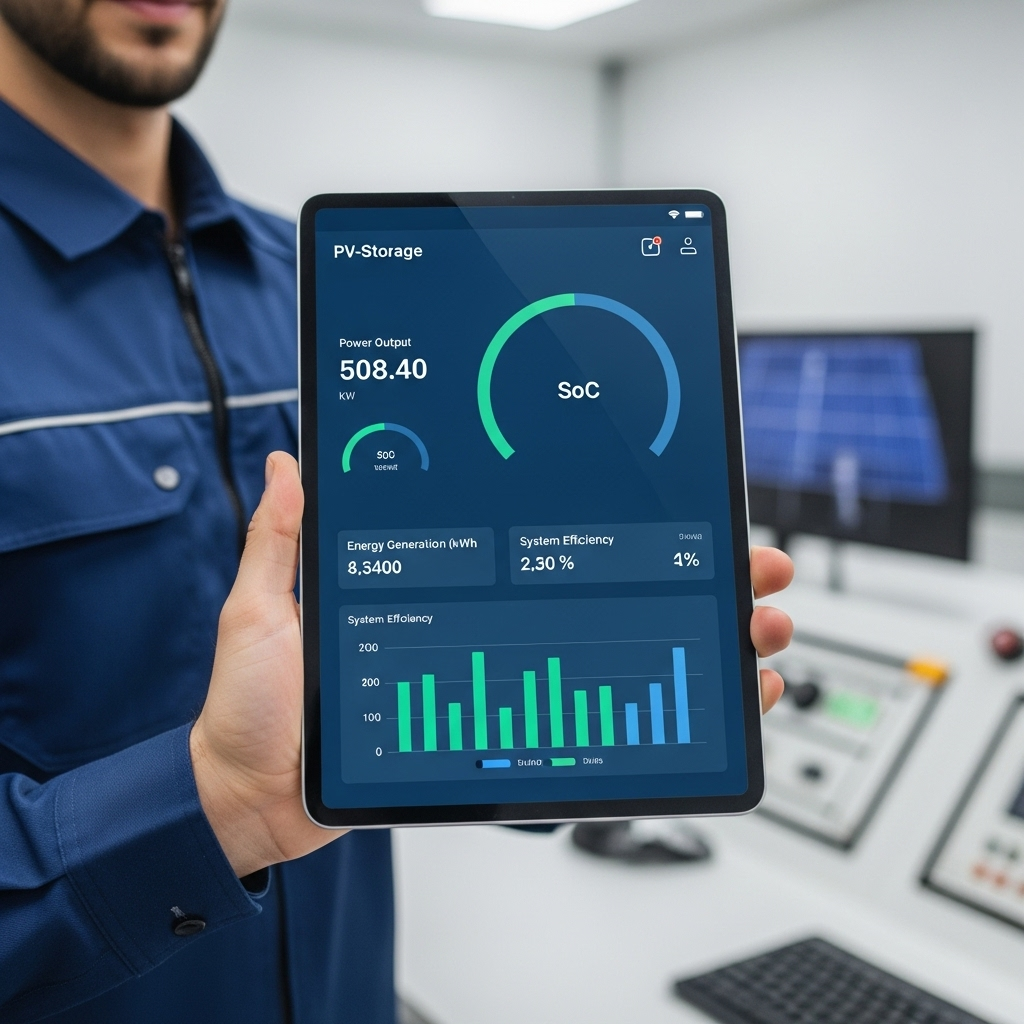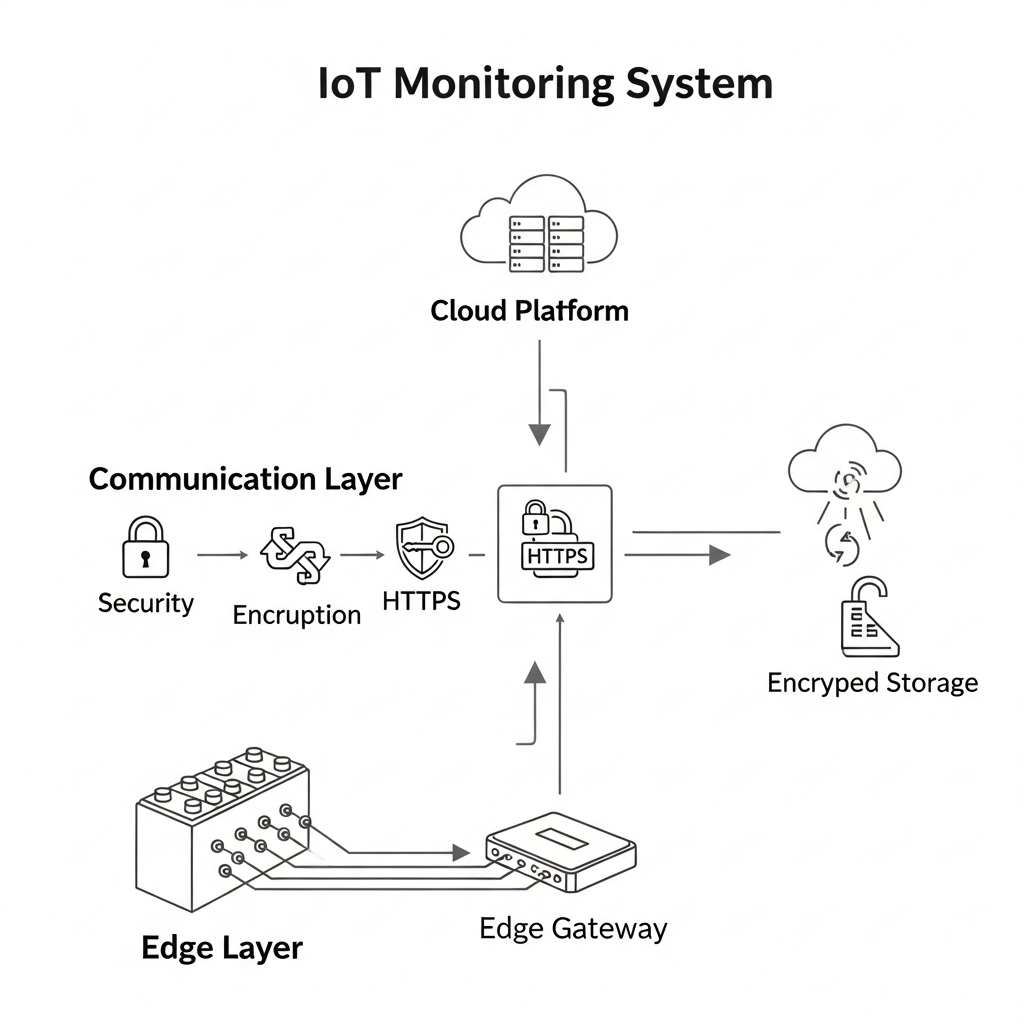Modern energy solutions are more than just hardware; they are intelligent, connected systems. At the heart of this transformation are Internet of Things (IoT) and Cloud Monitoring Platforms. These technologies act as the central nervous system for solar and energy storage systems, converting raw operational data into valuable, actionable information. For anyone seeking energy independence, understanding these platforms is key to maximizing efficiency, ensuring reliability, and maintaining control over your energy assets.
Core Components of an IoT-Enabled Energy System
A complete monitoring solution consists of several layers working in concert. From the hardware that captures data to the cloud platform that processes it, each component plays a distinct role.
Hardware: The Sensory Layer
The foundation of any IoT monitoring system is the hardware that gathers data directly from the source. In a solar energy storage system, this includes sensors and data loggers integrated within key components. For example, the Battery Management System (BMS) in our high-performance LiFePO4 batteries constantly tracks critical parameters like voltage, current, and temperature. Similarly, our solar inverters monitor energy production and conversion efficiency. This raw data is the essential input for the entire monitoring process.
Connectivity: The Communication Bridge
Once data is collected, it needs a pathway to the cloud. This is where connectivity comes in. Common methods include Wi-Fi, cellular (4G/5G), and Ethernet. The right choice depends on the application. A residential home energy storage system might use an existing Wi-Fi network, while our off-grid solar solutions for remote farms or cabins would benefit from the reliability of a cellular connection. This ensures that no matter the location, a steady stream of data is always available for analysis.
The Cloud Platform: The Brains of the Operation
The cloud platform is where the magic happens. It receives, stores, and processes the vast amounts of data sent from the hardware. Using powerful analytics, it transforms numbers into intuitive dashboards, performance reports, and actionable alerts. This is what enables powerful features like remote diagnostics, performance optimization, and predictive maintenance alerts, giving you a complete view of your system's health from anywhere in the world. For managing multiple systems, this centralized view is indispensable. You can learn more about how this applies to large-scale operations in our Ultimate Guide: IoT Cloud Monitoring for Solar ESS at Scale.
Communication Protocols and Interoperability
For different devices within an energy system to communicate effectively, they must speak the same language. This is governed by communication protocols. However, ensuring all components can work together—a concept known as interoperability—remains a significant challenge.
Key Communication Protocols Explained
Several protocols are used in the energy industry, each with specific strengths. Modbus is a long-standing, robust protocol common in industrial equipment. MQTT is a more lightweight, modern protocol designed for IoT devices with limited bandwidth. SunSpec is an open standard specifically created to ensure plug-and-play interoperability between solar and storage components. Understanding the differences is crucial when designing a system, a topic we explore further in MQTT vs Modbus vs SunSpec: Picking ESS Data Protocols.
| Protocol | Primary Use Case | Complexity | Key Advantage |
|---|---|---|---|
| Modbus | Industrial control systems, inverters, meters | Low | Widely supported, very reliable |
| MQTT | IoT sensors, remote monitoring | Low to Medium | Lightweight, efficient for low-bandwidth networks |
| SunSpec | Solar inverters, energy storage | Medium | Standardized data models for interoperability |
| CAN | Battery Management Systems (BMS), automotive | Medium | Robust and fault-tolerant for critical systems |
The Challenge of Interoperability
In an ideal world, any inverter could seamlessly communicate with any battery. In reality, many manufacturers use proprietary protocols, which can lead to vendor lock-in. This limits your choices and can make system expansion difficult. This is why advocating for and building systems with open standards is a core part of providing reliable and scalable energy solutions. A well-designed system should allow for flexibility and future growth. For a deeper look into this issue, see our articles on How to Architect Interoperable IoT Telemetry and the Myth vs Reality of Vendor Lock-In.
Security and Compliance in Energy IoT
Connecting energy systems to the internet introduces powerful capabilities, but it also requires a serious approach to security and regulatory compliance. Protecting these systems is essential for ensuring stable operation and safeguarding user data.
Securing Data from Edge to Cloud
A robust security strategy protects data at every stage. Data transmitted from a device to the cloud must be encrypted to prevent unauthorized access. Industry-standard protocols like TLS 1.2 are essential for securing data in transit. Furthermore, strong authentication methods, such as RSA-2048 bit certificates, ensure that only authorized devices and users can access the system. These measures are not optional; they are fundamental to the design of a secure IoT platform. Learn more in our Security Blueprint for Energy IoT.
Navigating Industry Standards and Certifications
Safety and reliability are paramount. Certifications like UL 9540 provide a comprehensive safety standard for energy storage systems, covering everything from the battery cells to the inverter and control systems. Adhering to these standards ensures that the entire system has been rigorously tested and is safe to operate. Following a clear plan for compliance is critical, as detailed in our Roadmap to UL 9540-Aligned IoT Monitoring Architectures.
Practical Applications and Advanced Analytics
The true value of an IoT platform lies in its ability to turn data into intelligence that improves performance and reliability. This is achieved through advanced analytics and machine learning.
From Data to Actionable Insights
Cloud platforms analyze performance metrics to give you a clear picture of your system's health. Key metrics include the battery's State of Charge (SoC), Depth of Discharge (DoD), and overall round-trip efficiency. To optimize performance, you must first understand these core metrics. For instance, managing the DoD of your battery is vital for its longevity. You can find a detailed breakdown of these key performance indicators in our guide to solar storage performance. Tracking these values helps you make informed decisions to maximize your energy use, a topic covered in What Metrics Matter in PV-Storage Cloud Monitoring?.
Predictive Maintenance and System Optimization
One of the most powerful applications of IoT analytics is predictive maintenance. By analyzing historical data, cloud platforms can identify subtle anomalies that may indicate a future component failure. The system can then send an alert, allowing for maintenance to be scheduled before a problem occurs, which minimizes downtime and saves costs. This proactive approach transforms system maintenance from reactive to preventative, ensuring the long-term reliability of our integrated home energy storage systems. The evolution of this technology is rapid, as highlighted in 2025 Trends: Edge-to-Cloud Analytics for Home Storage.
Building a Future-Proof Monitoring Strategy
As technology evolves, your energy monitoring system should be able to adapt and grow with your needs. A forward-thinking strategy focuses on choosing the right platform and ensuring it can scale.
Choosing the Right Platform
Selecting an IoT platform requires careful consideration of several factors. Scalability is crucial—the platform should handle one system as efficiently as one hundred. A user-friendly interface for both desktop and mobile is also important for easy access to your data. Finally, robust security features and support for open communication standards ensure the platform is both safe and flexible. For a comparative look, see our Platform Review: Best IoT Clouds for Solar Inverters.
Scalability for Growing Energy Needs
Your energy needs may change over time. You might add more solar panels, increase your battery capacity, or even manage multiple properties. A scalable IoT architecture is designed to grow with you. This aligns with our mission to provide reliable and expandable energy solutions that support our customers on their path to energy independence. Proper planning ensures your monitoring capabilities are never outgrown, a concept central to our Ultimate Guide to IoT Cloud Monitoring at Scale.
Your Partner in Intelligent Energy Management
IoT and cloud monitoring platforms have fundamentally changed how we interact with energy systems. They are no longer just a feature but an integral part of a modern, efficient, and reliable energy solution. By providing deep insights, enhancing security, and enabling proactive maintenance, these platforms empower you with greater control over your energy future. As we continue to integrate smarter technologies into our solutions, from our LiFePO4 batteries to our complete off-grid systems, we remain focused on helping you achieve true energy independence.
Disclaimer: This article is for informational purposes only and does not constitute professional investment or legal advice. Please consult with a qualified professional for guidance specific to your situation.





Leave a comment
All comments are moderated before being published.
This site is protected by hCaptcha and the hCaptcha Privacy Policy and Terms of Service apply.